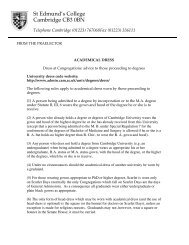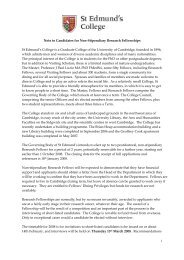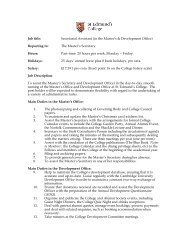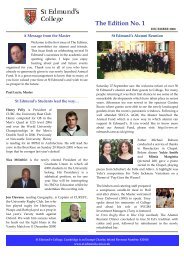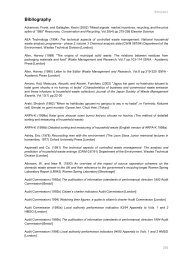Lecture - St Edmund's College - University of Cambridge
Lecture - St Edmund's College - University of Cambridge
Lecture - St Edmund's College - University of Cambridge
Create successful ePaper yourself
Turn your PDF publications into a flip-book with our unique Google optimized e-Paper software.
<strong>Lecture</strong> Contents<br />
Pr<strong>of</strong>essor Andrews Briggs delivered this lecture on Thursday 10th March 2005 in the<br />
Octagon Theatre, <strong>St</strong> Catharine’s <strong>College</strong>, <strong>Cambridge</strong>. The lecture was followed by<br />
questions from the audience and later a dinner/discussion at <strong>St</strong> Edmunds <strong>College</strong>. A<br />
transcript <strong>of</strong> the lecture and the discussion can be viewed in html or downloaded as a<br />
pdf file, and an audio recording <strong>of</strong> the lecture and questions is also available at<br />
http://www.st-edmunds.cam.ac.uk/cis.<br />
Brief Biography<br />
Andrew Briggs studied for a degree in Physics at Oxford, followed by<br />
a PhD at <strong>Cambridge</strong> in the 1970s. He then did a degree in Theology<br />
and went back to Oxford where he is now Pr<strong>of</strong>essor <strong>of</strong><br />
Nanomaterials and Director <strong>of</strong> the Quantum Information Processing<br />
Interdisciplinary Research Centre.<br />
Nanotechnology - Grey goo or great God?<br />
Bob White: I would like to welcome Pr<strong>of</strong>essor Andrew Briggs, who studied for a<br />
degree in Physics at Oxford, followed by a PhD at <strong>Cambridge</strong> in the 1970s. He then<br />
did a degree in Theology and went back to Oxford where he’s now Pr<strong>of</strong>essor <strong>of</strong><br />
Nanomaterials. Today’s lecture is on Nanotechnology. We look forward to him telling<br />
us both about that subject and about how his Christian faith is related to his work.<br />
Andrew Briggs: Thank you very much indeed, Bob, for the invitation. There are<br />
three lectures taking place simultaneously in <strong>Cambridge</strong> at this moment. One <strong>of</strong> them<br />
is the Archbishop <strong>of</strong> Canterbury speaking, the second one is that Lord Broers, former<br />
Vice Chancellor <strong>of</strong> <strong>Cambridge</strong> is giving the Reith <strong>Lecture</strong> and the third one is just me!<br />
I am neither <strong>of</strong> the other two, so if you thought you were coming to hear the Reith<br />
<strong>Lecture</strong>, or the Archbishop <strong>of</strong> Canterbury, I shall quite understand if you want to leave<br />
now!<br />
What is Nanotechnology? A report that was put<br />
together by a combination <strong>of</strong> the Royal Society and the<br />
Royal Academy <strong>of</strong> Engineering that came out last summer<br />
identified two topics. Nanoscience is the study <strong>of</strong><br />
phenomena and the manipulation <strong>of</strong> materials at atomic,<br />
molecular and macromolecular scales, where properties<br />
differ significantly from those that are larger scale.<br />
Nanotechnologies are the design, characterisation,<br />
1
production and application <strong>of</strong> structures, devices and systems by controlling shape<br />
and size at the nanometre scale. I’ll talk a little in a moment about what a nanometre<br />
is, but loosely speaking people think <strong>of</strong> nanotechnologies as being around a hundred<br />
nanometres or less. They think <strong>of</strong> nanoscience as the study <strong>of</strong> materials and systems<br />
and devices at that scale, and they think <strong>of</strong> nanotechnologies as actually manipulating<br />
them and doing engineering with them. The key point is that nanotechnology<br />
becomes interesting when small is not the same as big, when the very smallness <strong>of</strong><br />
the materials and structures that you’re looking at makes a significant difference to<br />
their properties and behaviour.<br />
It is helpful to think <strong>of</strong> these things on a series <strong>of</strong> different scales. The diagram<br />
shows a metre and then every time we move one tick to the right we divide by ten:<br />
that’s ten centimetres – a football is somewhere around here – and then as we come<br />
down that’s ten millimetres, that’s one millimetre, there’s a little tiny flea that you might<br />
be able to see with your eye – I don’t know who it came from! Human hair is about 80<br />
thousandths <strong>of</strong> a millimetre, this is a thousandth <strong>of</strong> a millimetre, or micrometre. Now<br />
we’re getting down to blood cells and then even smaller little viruses and so on at a<br />
scale <strong>of</strong> about a tenth <strong>of</strong> a micrometer - that’s a ten-thousandth <strong>of</strong> a millimetre. A<br />
hundred nanometers marks the onset <strong>of</strong> nanotechnology. Even smaller is the scale <strong>of</strong><br />
one nanometre, which is one-thousandth <strong>of</strong> one-thousandth <strong>of</strong> one-thousandth <strong>of</strong> a<br />
metre, a billionth <strong>of</strong> a metre. There we’ve got something the size <strong>of</strong> sixty carbon<br />
atoms which, by a fascinating coincidence, are arranged geometrically in a pattern<br />
that maps on to the football over here. Here you’ve got that scale drawn out, in this<br />
case, on a linear scale and we’ll look at one or two <strong>of</strong> these things as we go through.<br />
DNA would be down here, close to a nanometre in diameter.<br />
Another way <strong>of</strong> visualising all that is to zoom out and imagine that we’re<br />
looking at the earth which is about ten thousand kilometres in diameter. As we zoom<br />
in, we can imagine ourselves looking at things in higher and higher magnification. At<br />
about two kilometres across we can pick out a football field. As we zoom in on that,<br />
we get down to a man about two metres high. This particular footballer has got a flea<br />
in his hair – there’s this human hair and remember this is 80 micrometres in diameter,<br />
80 thousandths <strong>of</strong> a millimetre and there’s the flea clinging on to it. When the picture<br />
is about 1 millimetre across and as we zoom in some more, we begin to see some red<br />
blood cells which are about 10 micrometres in diameter. We continue to zoom in and<br />
begin to see things like DNA and nanoparticles and now we’re beginning to move into<br />
the realm <strong>of</strong> nanotechnology, so now we’ve had to move away from what you might<br />
actually see down a microscope, to ball and stick models. We begin to look more<br />
closely still and here is that buckyball, about one nanometre across and with the same<br />
pattern on it as the football. We can actually see those buckyballs. Later on I’ll show<br />
you some pictures but now we’re beginning to move into the realm where all you can<br />
do is start to draw cartoons. At about a tenth <strong>of</strong> a nanometre in diameter we’re<br />
moving to the stage where you could never see a picture like this with any microscope<br />
at all, you can only draw cartoons <strong>of</strong> them, and so on into the structure <strong>of</strong> an atom. I<br />
hope that gives you a picture <strong>of</strong> how one might zoom in across those different sizescales<br />
to get some feeling for where the realm <strong>of</strong> nanotechnology lies, in this regime<br />
from one hundred nanometres down to about one nanometre.<br />
When one thinks about working in this realm <strong>of</strong> things that are below about a<br />
hundred nanometres or so, there are many people who realise that they have been<br />
working in this area for years and years without ever calling it nanotechnology at all;<br />
for example, the great majority <strong>of</strong> chemistry is done on that scale. I am reminded <strong>of</strong><br />
Molière’s Le Bourgeois Gentilhomme where the tutor is teaching Monsieur Jourdain<br />
about how speech works and explains to him what prose is, and Jourdain responds<br />
“Well, what do you know about that, these forty years now I have been speaking in<br />
prose without knowing it! How grateful I am to you for teaching me that”. There may<br />
2
e lots <strong>of</strong> people around who, for at least forty years, have been working in<br />
nanotechnology without ever knowing it and they’re grateful now to know it.<br />
Our bodies have used nanotechnology all our lives and there are some<br />
remarkable kinds <strong>of</strong> nanotechnology going on in the body. Your stomach works by<br />
marvellous little nanotechnology motors pumping stuff in and out from place to place<br />
inside your body. Our muscles, anything that we move when we want locomotion, are<br />
a kind <strong>of</strong> nanotechnology – this little movie illustrates the way that myosin works when<br />
your muscles contract and expand. Many <strong>of</strong> the mechanisms were discovered by<br />
Andrew Huxley, who was working in London but living in Grantchester. Those things<br />
are found in the natural world, found in our bodies, and some people see amazing<br />
design in them; I’ll come back to that later. But <strong>of</strong> course nanotechnology primarily<br />
means what we can do and ways that we can engineer things and that has gone from<br />
strength to strength in recent years.<br />
This diagram shows an example <strong>of</strong> using a beam <strong>of</strong><br />
gallium ions to cut away a groove in a hightemperature<br />
superconductor. This is a scale <strong>of</strong> about<br />
five hundred nanometres and you can see that the<br />
ion beams are milling this material with terrific<br />
precision; these can be used to do machining <strong>of</strong><br />
materials on a scale down to about fifty nanometres.<br />
A breakthrough in the field came in 1990 when Don<br />
Eigler, working at IBM laboratories in Almadon in<br />
California, moved individual xenon atoms around on<br />
a surface and, because he was working for IBM and perhaps wanted to get a pay rise,<br />
he thought a good way to demonstrate it would be to write the IBM logo. Each <strong>of</strong><br />
these is an individual xenon atom that he’s moved to the place where he wanted it to<br />
be. That means that fifteen years ago the stage was reached where it was possible to<br />
move atoms on a surface to a location <strong>of</strong> your choice.<br />
One <strong>of</strong> the great drivers for nanotechnology is<br />
the progress that’s being made with computers.<br />
Babbage’s original calculating machine stood about a<br />
metre tall, and that has progressed to the transistors<br />
and now the integrated circuits that have been in use<br />
for thirty or forty years in computers. The question is<br />
how much smaller can you go on making them? This<br />
is a little device that was made in Tsukuba in Japan,<br />
a single electron transistor made with titanium dioxide on a titanium surface. Even<br />
this picture is about ten years old now.<br />
The head <strong>of</strong> Intel, Gordon Moore, observed that computers were getting<br />
smaller and smaller faster and faster and that the number <strong>of</strong> transistors on a chip was<br />
doubling roughly every 18 months. His observation has become known as “Moore’s<br />
Law”; it’s amazing the extent to which that trend has been maintained. Moore’s Law<br />
is a wonderful thing to show to management because all you do is put a linear scale <strong>of</strong><br />
years along here and a logarithmic scale <strong>of</strong> almost anything you like to do with<br />
computing up there, and you’ll probably get a straight line. If it’s something you want<br />
more and more <strong>of</strong> it’ll be a straight line going up, and if it’s something you want less<br />
and less <strong>of</strong>, like the number <strong>of</strong> electrons per device, you’ll find it coming down. This<br />
is the number <strong>of</strong> electrons per device on a logarithmic scale. By about 2015 or so we’ll<br />
be getting down to one electron per device. How do you get smaller than that?<br />
You’re hitting the regime where the quantization <strong>of</strong> matter is going to make a<br />
difference and that’s either going to stop you making further progress, or it may turn<br />
out to be something that you can exploit.<br />
3
As an illustration <strong>of</strong> Moore’s Law in practical terms, just over thirty years ago in<br />
1974, <strong>Cambridge</strong> had one mainframe computer, an IBM 360. The random access<br />
memory <strong>of</strong> the computer was increased from two to three megabytes and it was such<br />
a big event that it was the talk <strong>of</strong> the town; it seemed that everyone in <strong>Cambridge</strong> was<br />
discussing it. The other day I bought a little bit <strong>of</strong> memory here on this USB stick; it’s<br />
half a gigabyte, 516 megabytes, and it cost £20. That’s a practical illustration <strong>of</strong> the<br />
extent to which Moore’s Law is moving us along. Driven by these things and other<br />
considerations, people are studying the materials on the nanoscale.<br />
Let me give you an illustration <strong>of</strong> the kind <strong>of</strong> thing that we do<br />
in our own lab in Oxford. We look at these little buckyballs –<br />
here’s a cartoon <strong>of</strong> one – but here are some actual pictures<br />
<strong>of</strong> some. This is a transmission electron micrograph taken in<br />
Oxford by Dr Andrei Khlobystov; this is a single walled<br />
carbon nanotube with a diameter <strong>of</strong> about 1.4 nanometres,<br />
and each <strong>of</strong> these objects inside it is one <strong>of</strong> these little balls<br />
made up <strong>of</strong> sixty carbon atoms.<br />
When you buy your 2006 edition <strong>of</strong> the “Guinness Book <strong>of</strong> World Records”<br />
you’ll not only find an entry from Colin Humpheys’ laboratory for the smallest hole, but<br />
you’ll also find an entry for the smallest test tube. You’ll see pictures like this and the<br />
reason this is the world’s smallest test tube is that we did some experiments where we<br />
had a little length <strong>of</strong> this, about ten nanometres long, and inside it we put five<br />
molecules <strong>of</strong> C 60 and two or three oxygen atoms. The volume <strong>of</strong> that test tube is 10<br />
yoctolitres. A yoctolitre is a thousandth <strong>of</strong> a zeptolitre, so the volume is 0.01<br />
zeptolitres. The number <strong>of</strong> yoctolitres in a teaspoonful is roughly equal to the number<br />
<strong>of</strong> teaspoonfuls in all the world’s oceans. If you actually were to look over the<br />
shoulder <strong>of</strong> Andrei Khlobystov, who took the pictures, this is the sort <strong>of</strong> thing that you<br />
would see in the electron microscope. Here<br />
is our single-walled carbon nanotube and<br />
then these molecules actually have 82<br />
carbon atoms in them; inside each one <strong>of</strong><br />
these there is one atom <strong>of</strong> cerium, so you’re<br />
seeing one atom <strong>of</strong> cerium inside a cage <strong>of</strong><br />
82 carbon atoms inside this single walled<br />
nanotube which is about 1.4 nanometres<br />
diameter.<br />
I hope that these pictures give you a glimpse <strong>of</strong> what real nanotechnology<br />
actually looks like, but as you well know there’s a great deal <strong>of</strong> confusion around<br />
about nanotechnology, sometimes propagated by people who ought to know better. I<br />
would like to tell you a little bit about where this confusion comes from and what its<br />
sources are.<br />
Nanotechnology was first popularised by a film made in 1968 <strong>of</strong> Isaac<br />
Asimov’s science fiction story Fantastic Voyage. I’m told that at the time people went<br />
to see it because it starred Raquel Welch! It’s the story <strong>of</strong> some scientist whose work<br />
is crucial to the US defence effort who gets some sort <strong>of</strong> problem or clotting in his<br />
brain. The way they decide to solve this is put a scientist and crew – and Raquel<br />
Welch – inside a submarine and shrink it down into a size where it can travel along<br />
the blood vessels to the brain, where they can fix everything by laser surgery. I did<br />
actually watch the film to find out what it’s about; I don’t recommend it, as it’s<br />
incredibly boring. There is the obligatory series <strong>of</strong> crises, for example, when they go<br />
through the heart and there’s great turbulence. There’s a great deal <strong>of</strong> science that<br />
wouldn’t work; if you shrunk a laser down to that size, the wavelength would be all<br />
wrong.<br />
4
There was a more recent film called Agent Cody Banks made in 2003 and I’ll<br />
show you a clip from that in a moment. The person who I think has done more to<br />
inform – and to misinform – the public about nanotechnology is a man called Eric<br />
Drexler who works out <strong>of</strong> Palo Alto in California. One <strong>of</strong> his books is called Engines <strong>of</strong><br />
Creation, in which he has all these fantastic machines that are supposed to be<br />
assembling things at a molecular level. Many people can’t quite decide whether he’s<br />
a nutter or a harmless enthusiast! These are pictures taken from his book: these are<br />
supposed to be individual atoms and here you see this marvellous desktop selfreplicating<br />
machine. The whole thesis <strong>of</strong> his early work was that you could create, at<br />
an atomic level, self-replicating machines. Most pr<strong>of</strong>essionals in this field find it so<br />
fantastic as to be not worthy <strong>of</strong> serious credence. The most famous person who has<br />
criticised it is Richard Smalley, one <strong>of</strong> the three people who was awarded the Nobel<br />
Prize for the discovery <strong>of</strong> fullerenes. In Drexler’s visions the self-replicating machines<br />
are very much smaller than viruses, which are the smallest known self-replicating<br />
things in biology and are a great deal smaller than cells. When people talk about what<br />
nanotechnology is going to do for us, you get two extremes, one <strong>of</strong> which is that<br />
nanotechnology will save the world. Let me show you this clip from Agent Cody<br />
Banks. … Well!<br />
The concept <strong>of</strong> nanotechnology became encapsulated in the public phrase <strong>of</strong><br />
“grey goo”. Eric Drexler wrote in 1986: “As engines <strong>of</strong> destruction, nanotechnology<br />
and other artificial intelligence systems will lend themselves to more subtle uses than<br />
do nuclear weapons. A bomb can only be used to blast things but nanomachines and<br />
artificial intelligence systems can be used to infiltrate seas or control a territory or a<br />
world.” And the American Spectator wrote that “The nightmare is that combined with<br />
genetic materials, and thereby self-replicating, these nanobots will be able to multiply<br />
themselves into a ‘gray goo’ that could outperform photosynthesis and usurp the<br />
entire biosphere, including all edible plants and animals.” That was 2001. The<br />
Guardian commented later that year “Grey goo is a wonderful and totally imaginary<br />
feature <strong>of</strong> some dystopian science fiction future in which nanotechnology runs riot and<br />
microscopic, earth-munching machines escape from a laboratory to eat the world out<br />
from under our feet”. The Agent Cody Banks film goes on like this … Well, there you<br />
are!<br />
In the novel Prey by Michael Crichton the hero Jack discovered his wife’s<br />
company had created a self-replicating nanotechnology, a swarm <strong>of</strong> microscopic<br />
machines. Originally meant to serve as a military eye in the sky, a swarm escaped<br />
into the environment seemingly intent on killing the scientists trapped in the facility.<br />
The dust jacket says “Drawing on up-to-the-minute scientific fact, Prey takes us into<br />
the emerging realms <strong>of</strong> nanotechnology and artificial distributed intelligence in a story<br />
<strong>of</strong> breathtaking suspense which was read by His Royal Highness Prince Charles”. In<br />
2003 the headlines read “Prince Charles fears grey goo nightmare”. That phrase<br />
doesn’t actually appear anywhere in Michael Crichton’s book and a year later Prince<br />
Charles had to say that he was misrepresented and that he did not believe in selfreplicating<br />
nanotechnology.<br />
Well, what are we to make <strong>of</strong> all this and what are to make <strong>of</strong> it particularly in<br />
the Christian perspective? I want to look one at a time at the two areas <strong>of</strong><br />
nanoscience and <strong>of</strong> nanotechnology.<br />
As we have seen, there are remarkable examples <strong>of</strong> nanoscience, both in<br />
biological systems and in those that we can create and study in the laboratory. Does<br />
any <strong>of</strong> it make a difference to our understanding <strong>of</strong> God as creator? To shed a bit <strong>of</strong><br />
light on this I want to draw out four belief paradigms.<br />
The first one is the position <strong>of</strong> the agnostic, a term coined by T.H. Huxley in<br />
the 19 th Century to mean one who holds that the existence <strong>of</strong> anything beyond<br />
5
material phenomena cannot be known. But although he coined it in that very precise<br />
sense, he rather quickly lost control <strong>of</strong> the word and it came to mean a sort <strong>of</strong> excuse<br />
for sitting on the fence and not making up your mind. The story is told that someone<br />
went to Benjamin Jowett, the Master <strong>of</strong> Balliol in the 19 th Century, and proudly told<br />
him that he was an agnostic. Jowett replied “Young man, in this university we speak<br />
Latin not Greek, and the Latin for agnostic is ignoramus.”<br />
“Atheism” means a disbelief in, or a denial <strong>of</strong>, the existence <strong>of</strong> God. The first<br />
use <strong>of</strong> it in the Oxford English Dictionary is from Francis Bacon in the 17 th Century, “A<br />
little superficial knowledge <strong>of</strong> philosophy may incline the mind <strong>of</strong> man to atheism”.<br />
“Deism” is a technical term which apparently was first used by Richard Bentley<br />
to mean belief in the existence <strong>of</strong> God with a rejection <strong>of</strong> revelation closely allied to<br />
the concept <strong>of</strong> natural religion.<br />
And finally there is “theism”, which the Oxford English Dictionary defines as<br />
belief in the deity or deities, as opposed to atheism; and specifically belief in one God<br />
as creator and supreme ruler <strong>of</strong> the universe, specifically in distinction to deism.<br />
Atheism does not deny revelation.<br />
I have summarised that in tabular form, in the diagram. You have two<br />
columns, one <strong>of</strong> them is headed creator and the other one sustainer. Agnosticism<br />
claims that you cannot know. Atheism denies that there is a God at all, so he’s<br />
neither creator nor sustainer. Deism acknowledges that there is a God who creates<br />
everything, but denies that there is any subsequent revelation and denies God’s<br />
activity in the world now. And theism affirms God’s activity in creation and his activity<br />
in the world; indeed there’s really no distinction between the two.<br />
This becomes significant when you try to examine the<br />
argument from design. The old argument from design says<br />
that the exquisite structure <strong>of</strong> the world and <strong>of</strong> animal<br />
systems, and we might now say <strong>of</strong> biomolecular systems,<br />
seems to be perfectly intended for their optimum function.<br />
What is the origin <strong>of</strong> this? Paley, early in the 19 th Century,<br />
used the analogy that if you find a watch on a beach, you<br />
would infer that there must be a watchmaker. Charles<br />
Darwin said Paley’s work was one <strong>of</strong> the few things he really<br />
benefited from when he was studying here at <strong>Cambridge</strong>.<br />
The argument from design has re-emerged recently in the particular form <strong>of</strong> so-called<br />
intelligent design. There was a tour last year by Philip Johnson, a lawyer and<br />
pr<strong>of</strong>essor at <strong>University</strong> <strong>of</strong> California at Berkley, who was touring the UK advocating<br />
something rather analogous to intelligent design. Many people have come across<br />
intelligent design through a book called Darwin’s Black Box, written by Michael Behe,<br />
who is a pr<strong>of</strong>essional biologist by training. Loosely speaking you can say that<br />
intelligent design admits that evolution occurs but identifies lacunae in the evidence<br />
for evolution, where it says “Ah, you see there, that must have been God working; that<br />
shows that there’s an intelligent designer behind it all”. An important component <strong>of</strong><br />
this kind <strong>of</strong> argument is that you have to show the inadequacy <strong>of</strong> the normal scientific<br />
study in the field.<br />
In Chapter 1 <strong>of</strong> Darwin’s Black Box, Behe writes “This book is about an idea–<br />
Darwinian evolution–that is being pushed to its limits by discoveries in biochemistry….<br />
When sciences such as physics finally uncovered their foundations, old ways <strong>of</strong><br />
understanding the world had to be tossed out, extensively revised, or restricted to a<br />
limited part <strong>of</strong> nature. Will this happen to the theory <strong>of</strong> evolution by natural selection?”<br />
I’m not sure that many physicists will recognise that old ways <strong>of</strong> understanding were<br />
tossed out by new discoveries and I’m not sure how many biologists would subscribe<br />
to that either. But whatever the details, the fundamental misunderstanding is coming<br />
6
from a mistaken kind <strong>of</strong> view about how God works in the world. Here’s a picture <strong>of</strong> a<br />
green circle which encapsulates all observed phenomena; if you have no science at<br />
all, then none <strong>of</strong> it can be explained and so all <strong>of</strong> it is caused by God. As science<br />
progresses you begin to get bits on the left hand side that we can explain and those<br />
are caused by science, and so there’s a little bit less caused by God. As science<br />
progresses, I suppose we could extrapolate to the time when we’ll be able to explain<br />
the whole lot. Carl Sagan, in his foreword to A Brief History <strong>of</strong> Time by <strong>St</strong>ephen<br />
Hawking, talks about a universe with no age in space, no beginning or end in time,<br />
and nothing for the creator to do. This picture is sometimes described as God <strong>of</strong> the<br />
Gaps, and just before Pr<strong>of</strong>essor White wishes he had never invited me to speak, I<br />
should quickly say that that picture is utterly wrong. It’s wrong for all sorts <strong>of</strong> reasons.<br />
It’s wrong to think that “all observed phenomena” is a constant; I actually think the<br />
observed phenomena are expanding rather faster than our ability to explain them. But<br />
it’s most wrong to suppose that what we can give an account <strong>of</strong> scientifically is<br />
therefore no longer caused by God.<br />
Rather preferable is the inscription that you<br />
find on the doors <strong>of</strong> the old Cavendish Laboratory in<br />
Free School Lane, <strong>Cambridge</strong>, where now the<br />
Department Materials <strong>of</strong> Materials Science and<br />
Metallurgy is – we’ve got at least two Pr<strong>of</strong>essors <strong>of</strong><br />
Materials here and various other distinguished<br />
research fellows as well. If you go in from the Free<br />
School Lane entry you’ll pass that inscription in<br />
Gothic script, so it’s not very easy to read, in Latin,<br />
which a decreasing proportion <strong>of</strong> <strong>Cambridge</strong><br />
scientists are able to understand. It was put there at the request <strong>of</strong> Clerk Maxwell, the<br />
first Cavendish Pr<strong>of</strong>essor. There’s a sequel to that which is described in the<br />
European Journal <strong>of</strong> Physics in an article on the Cavendish Laboratory by Pr<strong>of</strong>essor<br />
Sir Brian Pippard. “The great oak doors opening on the site <strong>of</strong> the original building<br />
had carved on them, by Maxwell's wish, the text from Psalm 111 Magna opera Domini<br />
esquisita in omnes voluntates ejus. Shortly after the move to the new buildings in<br />
1973 a devout research student suggested to me that the same text should be<br />
displayed, in English, at the entrance. I undertook to put the proposal to the Policy<br />
Committee, confident that they would veto it; to my surprise, however, they heartily<br />
agreed both to the idea and to the choice <strong>of</strong> Coverdale’s translation, inscribed here on<br />
mahogany by Will Carter.” He also relates the legend that when Lord Rayleigh<br />
wished to use the same text to stand at the beginning <strong>of</strong> the six volumes <strong>of</strong> his<br />
Collected Papers, <strong>Cambridge</strong> <strong>University</strong> Press demurred on the grounds that some<br />
might misunderstand who was the Lord referred to, but the text does actually stand in<br />
his collected papers.<br />
I was that devout research student. Here is a picture <strong>of</strong> the entrance to the<br />
new Cavendish Laboratory with the text carved with the William Coverdale translation.<br />
I love it, because what it says is that what scientists in the Cavendish Laboratory –<br />
and in any other research laboratory for that matter – are doing is studying how God<br />
makes the world work, and you could not get further away from the God <strong>of</strong> the Gaps<br />
than that.<br />
Let me go on rather more briefly to the question <strong>of</strong> what we should be doing<br />
with our new capabilities in nanotechnology, how we should be using it and,<br />
particularly, how we should answer the challenge that we’re not supposed to play at<br />
God. A key text in this is in Genesis where the writer describes God making man in<br />
his own image. The word for image is this root here, SLM; it’s a very rich word with a<br />
wealth <strong>of</strong> meaning in it. The meaning can relate both upwards to man’s relationship to<br />
God and outwards, or downwards if you like, to that over which he has dominion. I<br />
7
suppose that everyone would agree that the word “image” there refers to the whole <strong>of</strong><br />
man, not just his intellectual bit. In its original Hebrew it means predominantly just<br />
another one, a duplicate. It refers upwards to a relationship with God, in other words<br />
it means having similar properties to and hence the capacity to relate to. Claus<br />
Westermann in Creation wrote “Mankind is created to stand before God.” Eichrodt in<br />
his Theology <strong>of</strong> the Old Testament wrote “Personhood is bestowed on him as the<br />
distinctive characteristic <strong>of</strong> his nature.” The word also refers downwards to man’s<br />
relationship to creation; von Rad described man as God’s executive to take<br />
responsibility for the world. David Clines wrote “Man himself is the image <strong>of</strong> God, who<br />
has no image <strong>of</strong> his own”, referring to the fact that if someone conquered a territory in<br />
the ancient near East they would set up a statue <strong>of</strong> themselves to remind people who<br />
was boss. The word therefore includes the concept <strong>of</strong> accountability. Charlie Moule<br />
put it like this, “Perhaps the most satisfying <strong>of</strong> the interpretations <strong>of</strong> the meaning <strong>of</strong> the<br />
image <strong>of</strong> God in man is that which sees it as basically responsibility”.<br />
I want to end by talking about something that is being opened up by<br />
nanotechnology, particularly in the implementations <strong>of</strong> information processing, and<br />
this relates to new insights that have come about in the last twenty years or so<br />
concerning the physical nature <strong>of</strong> information. This is the timescale over which people<br />
have begun to realise the significance in the scientific world, but <strong>of</strong> course you can go<br />
much further back to John’s gospel where John wrote “the word flesh became.” I<br />
have given you a word-for-word translation <strong>of</strong> the Greek there because it emphasises<br />
how there’s a juxtaposition in that sentence <strong>of</strong> “word” and “flesh”. Λογος was a very<br />
rich term at the time that John was using it: it had a Hebrew background meaning the<br />
word <strong>of</strong> God, which was active and did things, and it also had a Greek connotation,<br />
particularly from the writings <strong>of</strong> Philo, as an encapsulation <strong>of</strong> a controlling principle <strong>of</strong><br />
the universe. John is describing how, in Christ, this Logos with all this rich association<br />
<strong>of</strong> meaning, actually became physical.<br />
People have been beginning to realise that many <strong>of</strong> the concepts that we<br />
would hitherto have thought <strong>of</strong> as abstract have a physical embodiment that is<br />
inseparable from their very nature. It may be that biologists and psychologists have<br />
been realising this for some time; here are one or two quotes from the “World <strong>of</strong><br />
Psychology” which I was given by Malcolm Jeeves, illustrating how concepts like<br />
behaviour and personality, and one might almost say responsibility and belief, are<br />
inseparably embodied in the physical stuff <strong>of</strong> the brain. There has been a growing<br />
evidence for that, perhaps most recently and most notably from functional magnetic<br />
resonance imaging. In my own field people have been realising progressively through<br />
the twentieth century that information, which one might previously have thought <strong>of</strong> as<br />
a sort <strong>of</strong> abstract quantity, is physical. In the 1940s Shannon developed the<br />
mathematical nature <strong>of</strong> information. It turned out that the mathematics that was used<br />
to describe information in a noisy environment was exactly and precisely the same as<br />
the mathematics that had been developed for statistical physics in the nineteenth<br />
century to describe gases; that is why in information theory, terms like entropy have<br />
come to be used. Every time we make a phone call or use the internet, we’re using<br />
technology that has been installed by engineers who have grown up being trained in<br />
Shannon’s mathematical theories <strong>of</strong> information.<br />
In 1985 David Deutsch, who lives up on Headington Hill in Oxford, started to<br />
talk about the physical nature <strong>of</strong> information. Having perceived that information is<br />
physical, and then at the tiniest level, what we now call nanotechnology level, when<br />
things are obeying the laws <strong>of</strong> quantum physics, he saw that information must be<br />
capable <strong>of</strong> being described in quantum form and that that would open up whole new<br />
possibilities for what you could do with information processing. Many people regard<br />
his Royal Society paper <strong>of</strong> 1985 as the manifesto <strong>of</strong> quantum computing; it has been<br />
followed by an explosion <strong>of</strong> research in the field.<br />
8
A critic <strong>of</strong> quantum computing in the early days was Rolf Landauer. Shortly<br />
before he died he became a little less sceptical and he wrote a paper “The Physical<br />
Nature <strong>of</strong> Information”, whose title has become something <strong>of</strong> a catchphrase. Much <strong>of</strong><br />
the paper is about quantum computing, but he also went on to talk about what this<br />
taught us about the nature <strong>of</strong> the world, and in particular the relationship between<br />
theory and the experiment. He ended up with a sort <strong>of</strong> anti-platonic kind <strong>of</strong> approach,<br />
refuting that in the beginning was theory and the physical world is the manifestation <strong>of</strong><br />
that; he would rather put it the other way round, or at least allow it to be something <strong>of</strong><br />
an epistimological circle. In describing this he quotes from the beginning <strong>of</strong> John’s<br />
gospel, where John is describing how in Christ, what was not physical became<br />
physical and was embodied (literally) in human form.<br />
I hope that I have given you some idea <strong>of</strong> what nanotechnology is, some idea<br />
<strong>of</strong> the real things we can do with nanotechnology in the biological, medical and<br />
computing worlds; there are further exciting things that can be done in a number <strong>of</strong><br />
other worlds. In the popular mind there is probably more disinformation about<br />
nanotechnology than accurate information and I hope that those <strong>of</strong> us who are<br />
scientists can help to put that right. The developments in nanoscience and in<br />
nanotechnology will raise in new forms the questions about what we learn about the<br />
creator from our study <strong>of</strong> science, and what sort <strong>of</strong> responsibility we are called upon to<br />
exercise as these new capabilities become available to us. Let me end with<br />
something for you to think about as you go to sleep. Here is a picture, which I<br />
suppose is meant to be a set <strong>of</strong> red blood cells, with this little nanobot injecting them.<br />
The finishing question is: where does that picture lie on the spectrum from pure<br />
fantasy to technological feasibility?<br />
Questions Following the <strong>Lecture</strong><br />
Rachel Oliver: I have a question to do with the God <strong>of</strong> the Gaps idea and wonder if<br />
you could comment. I find it very strange that Christians sometimes get scared <strong>of</strong><br />
evolution and come up with intelligent design, which strikes me as having a stupid<br />
God, saying “Oh I’ve done that bit wrong and I’m going to correct it; oh, and that bit<br />
too, I’ll have to correct it” to fit all these specific things in intelligent design. To me the<br />
main thing is if you’re going to accept religion, accept it.<br />
Andrew Briggs: I have very little to add to what you said, Rachel; I think you’ve<br />
said it all. I suppose the only thing I could comment on would be the consequence<br />
that I perceive <strong>of</strong> this, which is that, amongst believers, it leads to intellectual laziness.<br />
There are some real issues to grapple with in the question <strong>of</strong> how God acts in the<br />
world. There are some very difficult questions there and instead <strong>of</strong> addressing the<br />
challenging questions and wrestling with them, some people accept this sort <strong>of</strong> copout<br />
which says when the science gets difficult you just say that the scientists have got<br />
it wrong, and so on. So I don’t think that leads to intellectual rigour and I think it’s very<br />
unhelpful. I also think that it’s unconvincing to unbelievers who therefore don’t take it<br />
seriously and stay unconvinced. I don’t know if anyone else would like to add to that.<br />
Is there anyone here who wants to stand up and vigorously defend the concepts <strong>of</strong><br />
intelligent design?<br />
Q: What I would say is it poses questions but it must not be used as a cop-out. This<br />
idea <strong>of</strong> irreducible complexity is something which is still being argued, which people<br />
still find there’s a possibility you can argue about it. There’s the idea that if you can’t<br />
test a theory and you can’t attack it, then it’s very hard to make progress on<br />
understanding the theory better so it’s legitimate to attack evolution. You can’t<br />
dismiss the possibility that evolution is true and use that as an intellectual cop-out, as<br />
you say, but that doesn’t mean there are good arguments behind what some <strong>of</strong> the<br />
intelligent design people are trying to do – some <strong>of</strong> them are doing good science<br />
9
producing good questions but some theories need to be dismissed as a kind <strong>of</strong> a<br />
fantasy <strong>of</strong> creationism that is too intellectually ridiculous.<br />
Andrew Briggs: There are other people in this room who are much more<br />
pr<strong>of</strong>essional in the life sciences research than I am – I don’t know whether they want<br />
to comment, or whether you want to move on to other topics <strong>of</strong> discussion.<br />
Q: Can I ask a question about the perception <strong>of</strong> nanotechnology. Why do you think<br />
that the idea <strong>of</strong> nanobots and grey goo caught on so well? Why do people like to be<br />
frightened by new science?<br />
Andrew Briggs: I don’t know the answer to that question! I did actually read<br />
Michael Crichton's book Prey; I found it quite a good read and I thought it was rather<br />
fun, though I think he’s got into terrible trouble for his new book on global warming. I<br />
suppose it’s easier to make a scare story, and it makes the headlines better than just<br />
a story <strong>of</strong> steady systematic progress. It’s also quite difficult to communicate<br />
concepts like logarithmic scale to people who don’t have a strong foundation in<br />
mathematics, so you keep having to use analogies like my comparison between a<br />
yoctolitre and a teaspoon, and so on. Perhaps other people here have better answers<br />
to that question.<br />
Q: The point about scaremongering is that it masks genuine and probably really<br />
good ethical issues. I wondered from your lecture, apart from the scale <strong>of</strong> hiding all<br />
these other things, if there are other genuine ethical issues arising from<br />
nanotechnology that you wanted to highlight. While not scaremongering, do you think<br />
there are actually serious things that we should think about the consequent<br />
implications?<br />
Andrew Briggs: In the Royal Society - Royal Academy <strong>of</strong> Engineering report they<br />
do have a section on ethical issues that are raised, but it has to be said that it’s a very<br />
small, and in my view very weak section, compared with the amount they discuss<br />
about regulatory issues. That may <strong>of</strong> course be partly because <strong>of</strong> the brief <strong>of</strong> that<br />
report. There are some very important regulatory issues about safety and risk and so<br />
on, and my own observation is that those who are working pr<strong>of</strong>essionally in the field<br />
take these things extremely seriously. I know Alan (Windle), who’s here this evening<br />
and who probably has the world’s best production <strong>of</strong> nanotubes, has looked very<br />
carefully into the risk issues associated with nanotubes, both in his own laboratory<br />
and for others using them and working in the field. So there are very important risk<br />
and safety issues there but although the details are new, I don’t see that as a<br />
generically new family <strong>of</strong> questions that are different from other issues in the Control<br />
<strong>of</strong> Substances Hazardous to Health.<br />
Alan Windle: We just focus on particles, or nanotubes as a particularly shaped<br />
particle. Particles are bad news as a body basically - I don’t think it’s necessarily<br />
anything to do with them being nanosize. One key aspect is that regulation <strong>of</strong> the<br />
cleanest breathing air has hitherto been done on the basis <strong>of</strong> how many grammes<br />
there are per cubic metre <strong>of</strong> air. Of course if you’ve got something which is nanosize,<br />
you’ve got millions and millions <strong>of</strong> things per gramme and so there are moves to say<br />
there should be regulation by the number <strong>of</strong> atoms per particle. We have to look at the<br />
issue <strong>of</strong> asbestos: asbestos is a very nasty shaped particle. There is one subset <strong>of</strong><br />
the toxicologists who believe that shape in asbestos - or particularly nasty types <strong>of</strong><br />
asbestos – is the most important issue; there’s another school <strong>of</strong> toxicology saying it<br />
is a specific chemical activity that is the main problem. Those are nano-size particles.<br />
Just to bring it home, we take precautions in our lab dealing with<br />
nanoparticles. We don’t want them in the air because I don’t want my group to be<br />
breathing them. As we know from smoking, breathing particles is very bad news but<br />
my fear is that because we take so many precautions in terms <strong>of</strong> fume cupboards and<br />
10
suck a lot <strong>of</strong> air through them, I’m actually sucking in a lot <strong>of</strong> nasty air from the Lion<br />
Yard car park which is probably producing a much greater risk than the particles. I<br />
think it’s very important in terms <strong>of</strong> public perception that one is prepared, fairly and<br />
equally, to put before the public the benefits and risks, and leave it to the public to<br />
make up their minds. This is what we have learnt from Genetically Modified foods,<br />
that it was actually the sense <strong>of</strong> making a pr<strong>of</strong>it and therefore having the technology<br />
remain secret that I think fuelled that public controversy. We don’t want to make the<br />
same mistake with nanotechnology. But funnily enough it’s the grey goo thing which<br />
took the spotlight <strong>of</strong>f the risks <strong>of</strong> particles and that <strong>of</strong> course was seen as the huge<br />
fear, until Prince Charles got on the bandwagon.<br />
Q: I’d like to ask about the source <strong>of</strong> the rather scary predictions about<br />
nanotechnology. There is a fantasy <strong>of</strong> machines that will take us over and will become<br />
superior to human beings. It always seems to me that people who pose that are the<br />
computer scientists, who somehow assume that they will be in charge <strong>of</strong> these<br />
machines – there’s a sort <strong>of</strong> grandiosity about this, and I wonder if there’s a sort <strong>of</strong><br />
similar grandiosity <strong>of</strong> these rather scary fantasies about grey goo. The other<br />
possibility – perhaps I can just gently float it, I would be interested to hear what you<br />
think about it – is whether there’s something demonic about these fantasies.<br />
Andrew Briggs: That’s very interesting. There’s a fear <strong>of</strong> the unknown, so if you ask<br />
what should we be doing at a practical level about this I think there are two things that<br />
we cay say, though they are much easier to state than to implement.<br />
The first one is that there is a great need for those <strong>of</strong> us who have some sort <strong>of</strong><br />
knowledge <strong>of</strong> the field to take the trouble to communicate the factual, realistic,<br />
accurate scientific basis, in a form that communicates as effectively as a novel by<br />
Michael Crichton does. I think there is a big need for communication there.<br />
The second and even greater need is in the education particularly <strong>of</strong> kids at<br />
primary and secondary school. We are seeing a dearth <strong>of</strong> young people going into<br />
particularly the physical sciences, but maybe the life sciences too, and this is not<br />
restricted to the UK - it has been well documented in Australia where they have seen<br />
parallel problems to the sort <strong>of</strong> things that were described by Gareth Roberts in the<br />
UK. In all this discussion about ‘A’ levels and so on, we are doing a great disservice<br />
to the most able students by denying, for example, in ‘A’ levels the opportunity for<br />
them to use their mathematics in their science studies. It’s popularly said that<br />
students are not doing the science ‘A’ levels because they’re too hard; there may be a<br />
bit <strong>of</strong> truth in that, or a perception <strong>of</strong> it, but I think also that the syllabus is too boring,<br />
we’re not making it interesting enough and letting the kids use their full intellectual<br />
faculties. I don’t know how to relate that to your statement about demonic influences,<br />
but I do think those are practical things that we can do address the strangeness <strong>of</strong> the<br />
field by helping people to appreciate the underlying science.<br />
For more information about the <strong>Cambridge</strong> CiS-<strong>St</strong> Edmunds lecture<br />
series please see the website:<br />
www.st-edmunds.cam.ac.uk/cis<br />
This lecture was sponsored by the Templeton Foundation.<br />
Copyright 2005 <strong>University</strong> <strong>of</strong> <strong>Cambridge</strong><br />
11




